MAC's Believe It Or Not!
by John McDougald
Reprinted from "Crown Jewels of the Wire", February 1994, page 14
I'm sure many of you have been wondering what happened to Mac and his
terrific column. Well, among other things, Mac found out that being a full time
student meant exactly that -- it takes full time!! However, I have this huge
backlog of pictures that I have taken, and the Editor said that if I didn't write
a column while I was on semester break, she would be forced to retire the column
permanently. So, heeeeere's Mac.
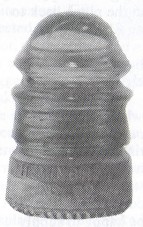
The pictures in this column all came from the Denver National last July.
First, we'll look at a couple of interesting embossings, that I'll describe as
"transition embossings". First is Bill and Jill Meier's CD 113
Hemingray/No12. The embossing is the normal one, except that a "9" is
clearly visible under the "1" in No12. Several examples have been
found where No9 is embossed on a CD 113, but this is the first one I've seen
"after" the embossing error was corrected.
Speaking of Hemingray 9' s,
here's one for you to look for. Sharp-eyed Richard Case (one of my best CD 106
suppliers) brought me a CD 106 on which the engraver used an upside-down
"G" to make the "9" in No9. There is no doubt!! How many of
those have you seen? I'll try to get a good picture for the next article.
The
Meier's CD 125 pictured (on the following page) has an unusual embossing
considering the insulator is adorned with drip points. (F-Skirt) W.U./5 (R-Skirt)
PATENT/DEC 19 1871/B. I don't believe I've seen a CD 125 with SDP that didn't
have the 1893 date. It's probably as unusual as a smooth base insulator
"with" the 1893 date.
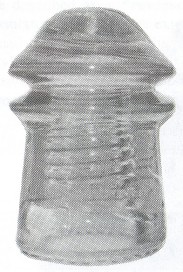
Speaking of drip points, here are some that didn't even find their way to an
insulator. I used to own one of these. It's embossed "PATENT MAY 2
1893" and has a nice set of sharp drip points. I'm guessing it's a
paperweight -- about 5 inches in diameter. David Wilson provided this go-with in
the 1893 display. If anybody has more information on this one let me know. I
know of three of them.
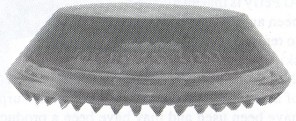
Warren Pickett brought this insulator from Dallas which seems to be missing
its drip points. This piece qualifies as a genuine sleeper. It is a CD 152
(F-Skirt) HEMINGRAY (R-Skirt) No 40. Notice the smooth base. This is only the
second one of these I've seen, and the first on had a 3/4" extended inner
skirt. This is an example of why it pays to go back through those junk boxes to
look at the Hemi 40' s one more time.
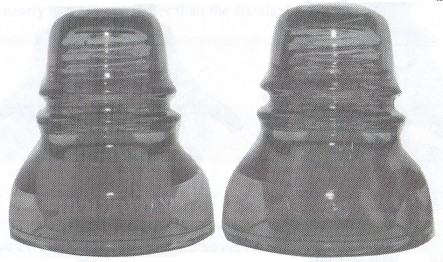
While we're thinking about inner skirts, here are a couple to add to your
list. Locke insulators in general seemed to have no standardization whatever in
the length of the skirts that were used. I had not seen a CD 296 with anything
but a modest inner skirt extension until the National. This one raises the insulator nearly 3/4" off the table. In
addition to being unusual in shape, this one is a pretty light blue.
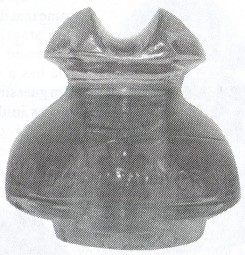
This next
picture may not be immediately identifiable. It is similar to a CD 244 with most
of the skirt broken off. The unusual thing about this piece provided by Al Perry
is that an oil cup has been annealed to the pinhole to replace what was the
inner skirt on the mold of the CD 244. None of the specimens that I have seen
(about 8) had any remnant of an attached oil cup. That's not really surprising
since they may not have been used and may have been a product of glasshouse
employee antics. However, there is mention in the literature of this insulator
design in use with an oil cup, and this is the first evidence of the existence
of the oil cup.
The hobby has officially recognized two distinct bases on the glass Cutter
(CD 1038) up to this time: the ribbed base which is described in the patent, and
the "coffin bottom" which has a hollowed out base, possibly for the
purpose of attaching a bracket. Pictured below is the third base style, which
belongs to Butch and Eloise Haltman and may be described as a "reverse coffin bottom". As you can see, the
insulator sits on a block extension which is located in the center of the
insulator rather than on the perimeter as it is on the coffin bottom. This style
may have been meant to accommodate a bracket as well since the curvature of the
base which was meant to fit the contour of the tree would no longer be in
contact with the tree.
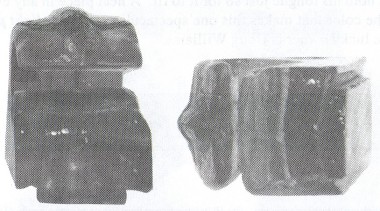
The 1893 display at the Denver National brought out some pieces that don't
see the light of day very often. Some of you may not have seen the CD 196
variations yet which belong to Dennis and Jeanne Weber. Pictured below are (on
the left) the only known example of CD 196.5 and (on the right) one of only a
handful of CD 196.2's. These pieces are nearly a full inch shorter than the
standard CD 196.
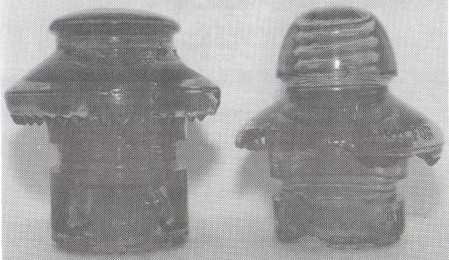
The next picture shows a couple of wonderful pieces that changed hands in the
past year. On the left is a base embossed CD 724 CHESTER. CD 724 is tough
enough, let alone embossed, and the color -- clam broth!!! For those of you who
don't have clam broth on your color chart, it's kind of a milky clear. On the
right is a CD 131 Tillotson. As you can see, the lineman who put this one on a
pin had to lean slightly to the right and hold his tongue just so for it to fit.
A neat piece in any event, but it's the color that makes this one spectacular as
well -- light pink/ SCA. The lucky owner is Doug Williams.
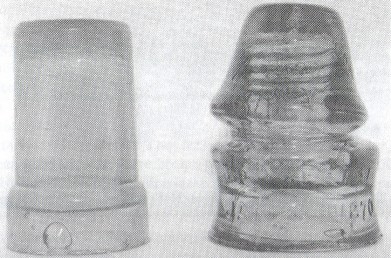
Pictured below are a couple more special threadless pieces. On the left is a
blackglass CD 727 and on the right is a variation in the CD 737 family in dark
teal which belong to John Ayers.
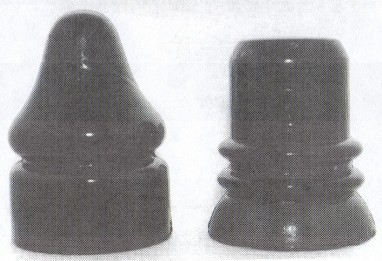
I've also pictured a couple of the very rare Salamander lightning rod
insulators. Gene Condon, Charleston S.C. has surfaced a number of these in his
area, and I believe he has them in four or five colors now. I'm sure he would
appreciate any information from other collectors who may have run across these
in their wanderings.
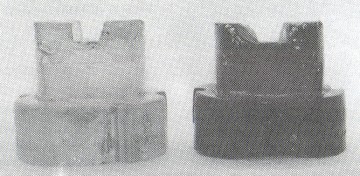
Finally, a what's-it for you to comment on. Unfortunately, I lost track of
it's owner. Here are three shots of a porcelain/composition piece approximately
4-1/2" in diameter. The pinhole is slightly larger than standard, and the threading is coarser than would fit a standard pin.
You may
have also noticed that the procedure for attaching a wire is not intuitively
obvious. However, rather than dismiss it as not being an insulator, I though you
ought to take a look and decide for yourselves. As usual, comments on all of the
above items are welcomed. Until next time, I will continue to work my way
through this enormous pile of pictures to share the best of them with you,
Believe It or Not!!!
| 